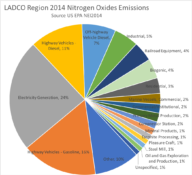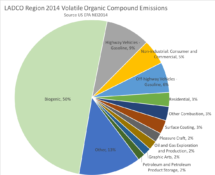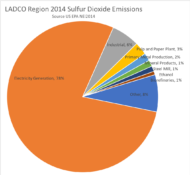Ground-level ozone pollution occurs in and near urban areas and the lakeshore during the summer months. Ozone is a secondary pollutant that is formed in the presence of sunlight from reactions of nitrogen oxides (a combustion by-product) and volatile organic compounds (fuels, industrial sources, solvents, and trees/plants). The unique weather of the Lake Michigan shoreline exacerbates ozone concentrations in our region.
Click here to learn more about ozone pollution in our region… Particulate matter (PM) pollution happens during all seasons and throughout the region. PM is directly emitted from combustion sources and as dust; and is formed through secondary reactions of by-products from combustion, industry, agriculture, and natural sources. Cold-weather chemistry and fuel use (residential wood burning) produce the highest observed PM concentrations in our urban areas during the winter months.
Carbon monoxide (CO), nitrogen oxides (NOx), volatile organic compounds (VOCs), sulfur dioxide (SO2), ammonia (NH3), particulate matter with a diameter < 10 um (PM10), particulate matter with a diameter less then 2.5 um (PM2.5), and lead (Pb) are common air pollutants that are harmful to human and ecological health. They are primary pollutants because they are directly emitted from sources. These pollutants are also precursors to harmful secondary pollutants, such as ozone which is formed through reactions of NOx and VOCs. See the emissions section below to learn about the sources of primary pollutants in our region.
Air toxics, or hazardous air pollutants (HAPs), are local, near source pollutants related to heavy industry, dense urban development, and roadways. They are known or suspected of causing cancer and other serious health effects. Examples of toxic air pollutants include benzene (gasoline), perchloroethylene (some dry cleaning facilities), and methylene chloride (a solvent and paint stripper by a number of industries). Examples of other air toxics listed by EPA include dioxin, asbestos, toluene, and metals such as cadmium, mercury, chromium, and lead compounds (Credit: US EPA).
Click here to find our more about HAPs from the U.S. EPA… Acid deposition, or acid rain, results when sulfur dioxide and nitrogen oxides (both combustion by-products from energy generation, transportation, and industry) are emitted into the atmosphere and transported by wind and air currents. These pollutants react with water, oxygen and other chemicals to form sulfuric and nitric acids, which then mix with water and other materials before falling to the ground. The acidic water that reaches the ground can harm plants and wildlife, such as insects and fish (Credit: US EPA).
Click here to find out more about acid deposition from the U.S. EPA… Mercury, lead, and other heavy metals deposit from the atmosphere to waterbodies, soils, and plants, accumulating in the environment and leading to fish and water consumption advisories. While mercury is naturally occurring in rocks and soils, it becomes a problem when it is released into the atmosphere. Human activities are responsible for much of the mercury that is released into the environment. The burning of coal, oil and wood as fuel can cause mercury to become airborne, as can burning wastes that contain mercury (Credit: US EPA).
Click here to find out more about mercury from the U.S. EPA… Haze impairs visibility throughout the region and is of particular concern in our cities and scenic areas. Haze is caused when sunlight encounters tiny pollution particles in the air, which reduce the clarity and color of what we see, especially during humid conditions. Natural sources of haze can include windblown dust, seasalt, and soot from wildfires. Manmade sources can include motor vehicles, electric utility and industrial fuel burning, and manufacturing operations. Particulate matter pollution from energy and industrial sources has historically been the major cause of haze in our region.
Click here to learn more about haze in our region…Wildfire smoke from areas as distant as California and Western Canada impacts our region in the summer and fall. Climate change, poor forest resources management, and growing encroachment of humans on forest ecosystems are attributed to more frequent and intense wildfires. Smoke from fires contains high concentrations of particulate matter, air toxics, and ozone precursors. Wildfire smoke also contributes to visibility impairment.








